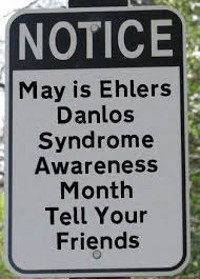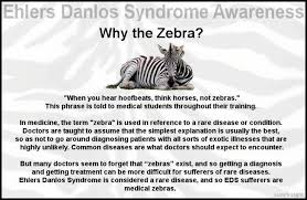May is EDS Awareness Month

Every chronic illness and issue has an awareness month, and May happens to be the month for Ehlers-Danlos Syndromes Awareness. So prepare to be beat about the ears and eyes with lots of awareness tweets, pins and Facebook posts by your afflicted friends or family.
However, THIS year (I’m updating this in April 2017 after first writing this in 2014), we have an entirely new diagnostic category to introduce and add to your awareness:
Hyperombility Spectrum Disorders
This new category now takes up the slack and “catches” all of those who are only a little bendy, or like me, have greatly stiffened with age even if they were very bendy before, and so no longer meet the newly tightened diagnostic criteria (since March 15th, 2017) for hypermobile Ehlers-Danlos Syndrome, the most common type.
It also now encompasses the former diagnostic categories of HMS, JHS and BJHS. And also covers those who may still be very globally bendy, but don’t quite have enough “issues with their tissues” to tick all the boxes for hEDS as shown here since 2017.
NB the “Brighton” (with an “r”) diagnostic criteria are now obsolete (have gone away), and they kept the Beighton (with an “e”) 9 pt hypermobility scale from them only. So that clears up some confusion there. (They were also off by only one letter, confusing everyone all these years!)
But they also tightened the sex and age-specific Beighton score required to be diagnosed with hypermobile EDS now, so fewer will meet that diagnostic criteria including me. They are hoping this will help to speed up research to find a common SNP (molecular genetic defect) or SNPs among those who still do meet the criteria since they will all be more similar in phenotype (disease expression).
This also allows doctors to continue calling ALL of the (now 14 as of April 2018) forms of EDS “rare” again. Though I will personally go to my grave insisting hEDS still isn’t, but don’t listen to me!
But, although technically hEDS is still considered rare, or was made so again, I still feel strongly that the collection of all forms of EDS as a whole is still not that rare, truly, even wihtout the addition of folks with the newly described HSDs. And even though some individual forms are extremely rare. Just like with cancer, the collection as a whole is not.
Learn more about the Hypermobility Spectrum Disorders here.
Please find the new 2017 International Classification and diagnostic criteria for all forms of the EDS and the new Hypermobility Spectrum Disorders here now. I urge downloading all 18 of the papers you can currently find there even if you don’t think they apply to you. They may apply to someone you know, and we need to get them into the hands of as many patients and doctors as possible to help raise awareness of this new nosology.
Common under or mis-diagnoses of both the EDS and HSD now include:
- Fibromyalgia (As most of you know, I strongly suspect this is really just EDS “lite” or HSD now. See my When to Suspect and When Else to Suspect pages.)
- Chronic Fatigue Syndrome
- Depression and anxiety (we may well have these, but they aren’t the whole picture by far!)
- Neuropathy and neuralgia
- Somatoform disorder
- Conversion disorder
- Munchausen’s by proxy
- Hypochondria
- Child abuse (from easy bruising of children with EDS when parents haven’t even touched them)
- Pain disorder
- Laziness (oh how hurtful this one is!)
- Alcoholism or drug addiction or drug seeking (likely masking underlying serious chronic pain from EDS and or neurodivergence or anxiety)
And any of the myriad comorbidities I’ve already listed on that page. Not that we don’t have any of these things, but… again, the diagnosis is missing the elephant in the room still, and only seeing the trunk or the tail to mangle the analogy.
In fact, after leading many support group meetings and hearing from patients there as well as observing thousands online for over six years now, I’m finding hypermobility tends to come with an entire package of comorbidities including allergies, sensitivites and autoimmune disease I unofficially but personally call the “Chronic Constellation” for as yet unknown reasons. (Though we now have one potential hypothesis to explain it.)
The thing is, the doctors often tend to diagnose the more easily recognized autoimmune diseases first, and miss the hypermobile forest for the inflamed trees! Autoimmune diseases have more easily measured biomarkers after all so constitute more low-hanging diagnostic fruit IMHO.
Hypermobility and Ehlers-Danlos Syndromes are NOT autoimmune to be clear. They are just commonly masked by and come with them highly comorbid, causing any additional underlying hypermobility and systemic connective tissue disease to be more easily missed.
Thousands have gone suffering for years from doctor to doctor in sometimes decades long journeys to diagnosis. I myself took over 25 years to finally be diagnosed from first my first major clinical presentation in my 20’s, only after going from walking to wheelchair in 3 weeks from a sudden “storm” of onset in 2012 at the age of 45 with no apparent trigger. I frankly stopped seeing doctors for a while, and stopped complaining about many issues after so much dismissal.
Others only get diagnosed after a sudden trauma (physical or emotional) or serious illness triggers such an onset “cascade” from which they never seem to recover. (Gee, Fibromyalgia seems to onset this way too, smile). So we really need your help changing the tide of understanding among as many doctors as possible. Thanks to the prevalence of narcissism in our families (and the medical community), too many are simply dismissed out of hand as whiners or complainers, invalidated and told to just “suck it up” and soldier through. (We come from very hard-charging driven smart families on the whole.)

What can you do to raise awareness besides wear the ubiquitous zebra stripes (our logo)? Lots! You can tweet, pin or FB post about it. You can share YouTube videos about it. You can hold a walk or rally about it. You can get a Gubernatorial Proclamation for your state declaring May Awareness Month as we did in Oregon thanks to a dedicated friend’s efforts.
You can write letters to the editor of your local paper. You can share your story or that of a friend’s on local media. You can hold fundraisers or art and craft sales. (We are an incredibly talented and crafty bunch who come up with tons of zebra-themed crafts all the time.) You can write an article in your school or work newsletter. You can share brochures or flyers with ballet schools, PT (physio) and chiropractic offices, doctors offices of all kinds, or put up a display board at a hospital or clinic.
You can ask your doctor to tell one other colleague (or more) about it. You can hold an informational session at a church or community hall. You can ask friends and family to join the now international scope Ehlers-Danlos Society (formerly the EDNF) or your local support organization. You can… fill in the blank___________! We are a super creative bunch, I’m positive there are many more ways to raise awareness than I’ve listed here!
Please share more ideas in the comments section below and share this and other posts far and wide anyway you like. And, if you haven’t already, please study up on how you do not have to be very bendy in order to be diagnosed with Hypermobililty Spectrum Disorders! (Our most common “myth” and misconception). Thanks for any efforts you make toward this end, no matter how small, every little bit helps!
The Ehlers-Danlos syndromes and Hypermobility Spectrum Disorders aren’t rare, just rarely diagnosed!
Let’s try to fix that!
Last updated May 1, 2023.


I have one close friend with it, have had one patient with it at work. (Used to work at psychiatric adolescent in-patient unit) And have seen two clients with EDS in my aromatherapy practice since taking early retirement from NHS. In every single case, the person with EDS went through years of not being believed! Will gladly do some tweeting/facebook posting.
Dave
Thanks so much Dave, you’re awesome to help spread awareness with us! I’m positive everyone has seen or knows someone with Ehlers-Danlos Syndrome, whether we all know it or not. And no, I don’t mean just me! Rock on – Jan
Hey everyone! Please learn about the BRAND NEW category for essentially “subclinical” hypermobile EDS patients that was just hatched this year in March 2017 here:
http://ohtwist.com/hypermobility-spectrum-disorders/
I will no longer say “EDS isn’t rare” as they just made it rare again with newly tightened diagnostic criteria you can find here. But I will definitely now say this new category of Hypermobility Spectrum disorders is NOT rare, just rarely diagnosed!
https://ehlers-danlos.com/2017-eds-international-classification/
Help me spread the word – thanks! And… be sure to download all 18 papers on the new criteria NOW (May 2017) before they go back behind a paywall in June 2017!